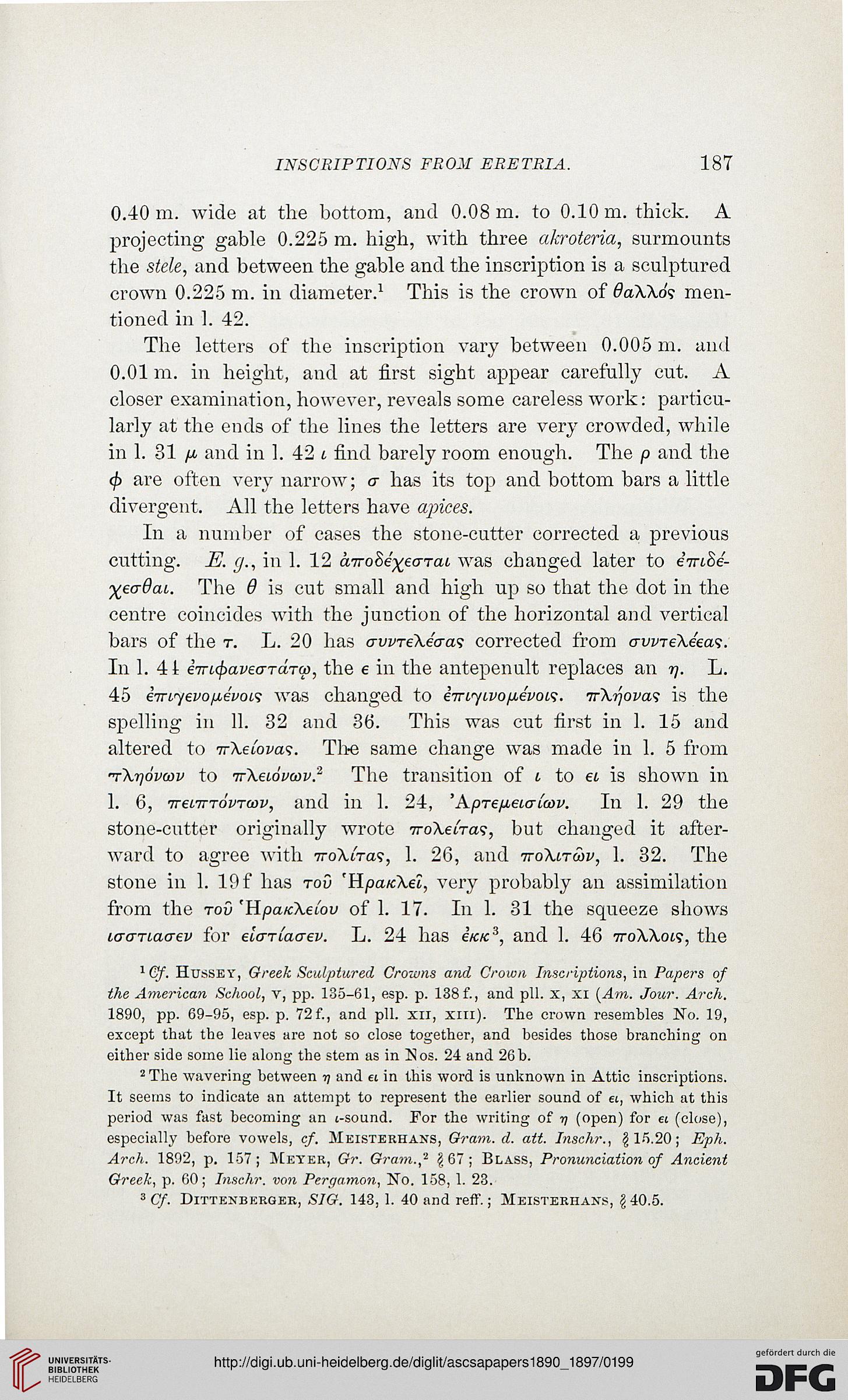INSCRIPTIONS FROM ERET1UA.
187
0.40 m. wide at the bottom, and 0.08 m. to 0.10 m. thick. A
projecting gable 0.225 m. high, with three akroteria, surmounts
the stele, and between the gable and the inscription is a sculptured
crown 0.225 m. in diameter.1 This is the crown of daXXos men-
tioned in 1. 42.
The letters of the inscription vary between 0.005 m. and
0. 01 m. in height, and at first sight appear carefully cut. A
closer examination, however, reveals some careless work: particu-
larly at the ends of the lines the letters are very crowded, while
in 1. 31 and in 1. 42 i find barely room enough. The p and the
are often very narrow; a has its top and bottom bars a little
divergent. All the letters have apices.
In a number of cases the stone-cutter corrected a previous
cutting. E. (j., in 1. 12 cnroSe^eo-Tai was changed later to eVtSe-
yeaQai. The 6 is cut small and high up so that the dot in the
centre coincides with the junction of the horizontal and vertical
bars of the t. L. 20 has o-vvreXeo-as corrected from awieXeew;.
In 1. 41 eincfiaveaTdrq), the e in the antepenult replaces an 7}. L.
45 iiri.'yevofjievoi'i was changed to iTriyiPo/xevoK. TrX-qova? is the
spelling in 11. 32 and 36. This was cut first in 1. 15 and
altered to nXeCovas. Th-e same change was made in 1. 5 from
"rX-qovcov to irXeiovwvr The transition of l to ei is shown in
1. 6, irenrTovTwv, and in 1. 24, 'Apre/xeiaicav. In 1. 29 the
stone-cutter originally wrote iroXeiTas, but changed it after-
ward to agree with TroXiras, 1. 26, and ttoXit&v, 1. 32. The
stone in 1. 19 f has rov 'HpaicXel, very probably an assimilation
from the rov 'HpcucXeiov of 1. 17. In 1. 31 the squeeze shows
laariaaev for etartaaep. L. 24 has eKK3, and 1. 46 iroXXof;, the
1Cy. Hussey, Greek Sculptured Crowns and Crown Inscriptions, in Papers of
the American School, v, pp. 135-61, esp. p. 138f., and pll. x, xi (Am. Jour. Arch.
1890, pp. 69-95, esp. p. 72 f., and pll. xn, xin). The crown resembles No. 19,
except that the leaves are not so close together, and besides those branching on
either side some lie along the stem as in Nos. 24 and 26b.
2 The wavering between -q and « in this word is unknown in Attic inscriptions.
It seems to indicate an attempt to represent the earlier sound of et, which at this
period was fast becoming an i-sound. For the writing of -q (open) for « (close),
especially before vowels, cf. Meisterhans, Gram. d. att. Inschr., §15.20; Eph.
Arch. 1892, p. 157; Meyer, Gr. Gram.,2 §67; Blass, Pronunciation of Ancient
Greek, p. 60; Inschr. von Pergamon, No. 158, 1. 23.
3 Cf. Dittenberqer, SIG. 143, 1. 40 and reft'.; Meisterhans, § 40.5.
187
0.40 m. wide at the bottom, and 0.08 m. to 0.10 m. thick. A
projecting gable 0.225 m. high, with three akroteria, surmounts
the stele, and between the gable and the inscription is a sculptured
crown 0.225 m. in diameter.1 This is the crown of daXXos men-
tioned in 1. 42.
The letters of the inscription vary between 0.005 m. and
0. 01 m. in height, and at first sight appear carefully cut. A
closer examination, however, reveals some careless work: particu-
larly at the ends of the lines the letters are very crowded, while
in 1. 31 and in 1. 42 i find barely room enough. The p and the
are often very narrow; a has its top and bottom bars a little
divergent. All the letters have apices.
In a number of cases the stone-cutter corrected a previous
cutting. E. (j., in 1. 12 cnroSe^eo-Tai was changed later to eVtSe-
yeaQai. The 6 is cut small and high up so that the dot in the
centre coincides with the junction of the horizontal and vertical
bars of the t. L. 20 has o-vvreXeo-as corrected from awieXeew;.
In 1. 41 eincfiaveaTdrq), the e in the antepenult replaces an 7}. L.
45 iiri.'yevofjievoi'i was changed to iTriyiPo/xevoK. TrX-qova? is the
spelling in 11. 32 and 36. This was cut first in 1. 15 and
altered to nXeCovas. Th-e same change was made in 1. 5 from
"rX-qovcov to irXeiovwvr The transition of l to ei is shown in
1. 6, irenrTovTwv, and in 1. 24, 'Apre/xeiaicav. In 1. 29 the
stone-cutter originally wrote iroXeiTas, but changed it after-
ward to agree with TroXiras, 1. 26, and ttoXit&v, 1. 32. The
stone in 1. 19 f has rov 'HpaicXel, very probably an assimilation
from the rov 'HpcucXeiov of 1. 17. In 1. 31 the squeeze shows
laariaaev for etartaaep. L. 24 has eKK3, and 1. 46 iroXXof;, the
1Cy. Hussey, Greek Sculptured Crowns and Crown Inscriptions, in Papers of
the American School, v, pp. 135-61, esp. p. 138f., and pll. x, xi (Am. Jour. Arch.
1890, pp. 69-95, esp. p. 72 f., and pll. xn, xin). The crown resembles No. 19,
except that the leaves are not so close together, and besides those branching on
either side some lie along the stem as in Nos. 24 and 26b.
2 The wavering between -q and « in this word is unknown in Attic inscriptions.
It seems to indicate an attempt to represent the earlier sound of et, which at this
period was fast becoming an i-sound. For the writing of -q (open) for « (close),
especially before vowels, cf. Meisterhans, Gram. d. att. Inschr., §15.20; Eph.
Arch. 1892, p. 157; Meyer, Gr. Gram.,2 §67; Blass, Pronunciation of Ancient
Greek, p. 60; Inschr. von Pergamon, No. 158, 1. 23.
3 Cf. Dittenberqer, SIG. 143, 1. 40 and reft'.; Meisterhans, § 40.5.




